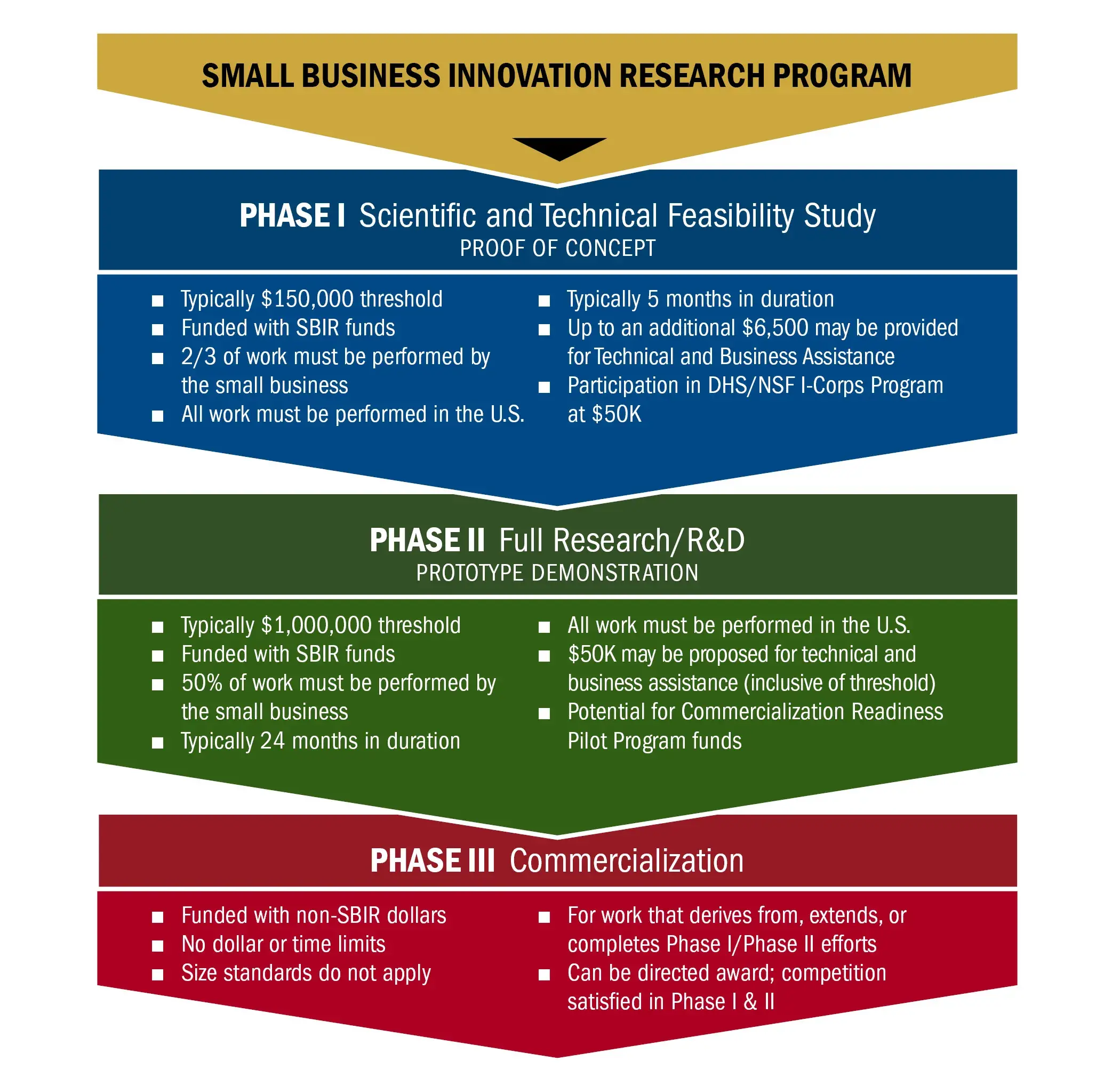The Small Business Innovation Research (SBIR) program, created in 1982 through the Small Business Innovation Development Act and reauthorized in 2011, is one of the largest public–private partnerships in the United States. The SBIR program encourages U.S. small businesses with fewer than 500 employees to provide quality research and to develop new processes, products and technologies in support of the missions of the U.S. government. Administered by DHS S&T, the DHS SBIR Program supports a full spectrum of SBIR initiatives serving all components.
created in 1982 through the Small Business Innovation Development Act and reauthorized in 2011, is one of the largest public–private partnerships in the United States. The SBIR program encourages U.S. small businesses with fewer than 500 employees to provide quality research and to develop new processes, products and technologies in support of the missions of the U.S. government. Administered by DHS S&T, the DHS SBIR Program supports a full spectrum of SBIR initiatives serving all components.
Upcoming Events
- National Small Business Federal Contracting Summit - Virtual — July 24
Sign up for a virtual one-on-one meeting with SBIR Outreach Manager, Connie Benesh, at the National Small Business Federal Contracting Summit that offers small business attendees educational resources and tools. Register to sign up for a meeting.
- Office of Small and Disadvantaged Business Utilization (OSDBU) Vendor Outreach Session (VOS) — August 22
Join our next VOS with Small Business Specialists and Prime Contractors on August 22, 9:00 a.m. – 12:15 p.m. ET. Meeting requests open August 8. Schedule your VOS by visiting the Small Business Vendor Outreach Sessions webpage.
Phase 0
DHS SBIR is proud to announce the launch of Phase 0, a program that can help potential applicants understand the submission process, provide access to assistance resources for new applicants and collaborate with individuals committed to diversifying the science and engineering workforce.
Now through January 2024, the Phase 0 program will offer the following series of webinars focused on providing more information about the 24.1 solicitation cycle:
- How a Small Business Should Approach Understand the Pre-Solicitation
- Mandatory Federal Registrations
- Confirming Eligibility and Using Your Time Wisely
- How to Prepare a Responsive Technical Proposal
- Principal Investigators and Other Personnel
- Preparing Your Budget
- Protecting Your Intellectual Property
- Important Forms to Submit with Your DHS Proposal
- DHS SBIR Proposal Submission Process
These webinars are recommended for all innovative R&D small companies interested in learning more about the SBIR program and process. Register here for the Phase 0 webinars.
 The DHS SBIR Program is a competitive award system which provides qualified small business concerns with opportunities to propose innovative ideas that meet specific homeland security research and development technology needs.
The DHS SBIR Program is a competitive award system which provides qualified small business concerns with opportunities to propose innovative ideas that meet specific homeland security research and development technology needs.
Phase I typically funds up to $175,000 for five months to determine the scientific and technical merit, and feasibility, of the proposed effort. Phase I awards are typically made within 45 days after selection.
Phase II typically funds up to $1,500,000 for 24 months to continue the R&D effort from the completed Phase I project and work towards a prototype demonstration. Only SBIR Phase I awardees are eligible to participate in subsequent phases. Options may be exercised for S&T SBIR Phase II projects that have firm commitments for follow-on funding.
Phase III is funded from a private or non-SBIR government source for commercialization or continued development and testing from an effort made under prior SBIR funding. Phase III work is typically oriented toward commercialization of an SBIR effort which can include products, production, services, research and development or any such combination. Phase III has no limit on the number, duration, type or dollar value of awards made to a small business. There is also no limit on the time that may elapse between a Phase I or Phase II award and a Phase III award, or between a Phase III award and any subsequent Phase III award.
We are committed to identifying promising small businesses and innovative approaches to help address homeland security needs. Our success stories highlight companies that have made lasting impacts to our nation with successful technological innovations through the DHS SBIR Program. These examples showcase a number of small businesses from around the nation that have worked with S&T to develop and support the technology needs of our nation and homeland security end-users. Read our DHS SBIR success stories!
Deconstructing SBIR Video Series
Watch our videos explaining the SBIR process:
- Detecting Trapped Survivors OATS RFI
- Insights Outreach | Getting Onboard with SBIR
- What's New in 2022!
- 2021 Other Agency Technology Solutions (OATS) RFI
- Planning for Privacy
- Innovate S&T: SBIR Proposal Submission Process
- Innovate S&T: Making the Most of Your One-on-Ones
- SBIR One-on-One Dos and Don'ts
- SBIR 20.1 Solicitation
- SBIR 21.1 Pre-Solicitation
- TechTalk: Small Business Innovation Research Program
News
- DHS Announces New 24.1 Small Business Innovation Research Pre-Solicitation - November 15, 2023
- DHS Awards $14.9M to 15 U.S. Small Businesses for R&D Prototypes - August 29, 2023
- DHS Awards $3.15M to 20 U.S. Small Businesses for Proof-of-Concept Research - July 6, 2023
- DHS Opens 23.1 Small Business Innovation Research Solicitation - December 19, 2022
- DHS Announces New 23.1 Small Business Innovation Research Pre-Solicitation - November 18, 2022
- DHS Awards $9.8M for Small Businesses to Develop Security Technology Prototypes - June 30, 2022
- DHS SBIR to Host First Responder Technology Showcase - March 22, 2022
- DHS SBIR Seeks Solutions to Detect Survivors in a Building Collapse - February 7, 2022
- DHS S&T Announces Small Business Innovation Research Pre-Solicitation - November 22, 2021
- DHS Awards $1M to California Small Business for Soft Targets and Crowded Places Security Solutions - October 6, 2021
The DHS SBIR Program issues an annual solicitation with topics that cover DHS mission areas for which proposals are sought. Topics for solicitations are solicited by S&T and CWMD and address the needs of DHS Operational Components including the Federal Emergency Management Agency, Cybersecurity and Infrastructure Security Agency, Transportation Security Administration, U.S. Citizenship and Immigration Services, U.S. Coast Guard, U.S. Customs and Border Protection, U.S. Immigration and Customs Enforcement, and U.S. Secret Service—as well as first responders. As such, the solicitations typically consist of topics relevant to the following organization focus areas:
To learn more about the DHS SBIR Program and current solicitations please visit the SBIR program portal.
For more information about the SBIR program, contact the Program Director at STSBIR.Program@hq.dhs.gov.
For more information about CWMD’s SBIR program, contact the Program Manager at CWMD.SBIR@hq.dhs.gov.
